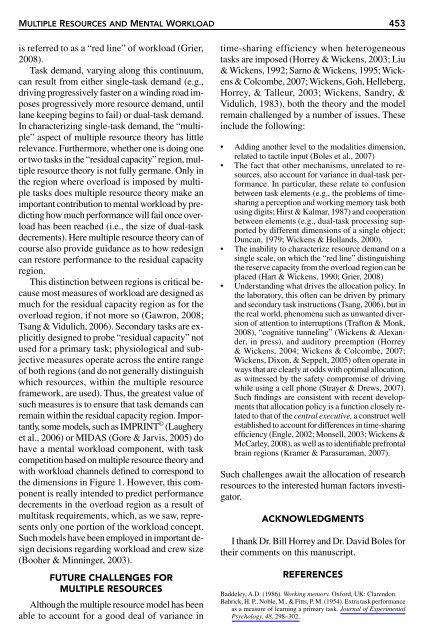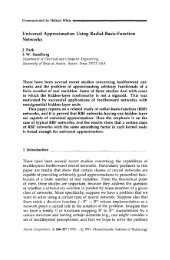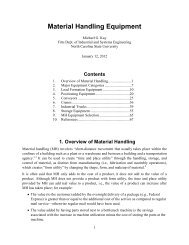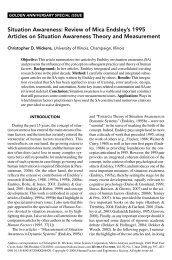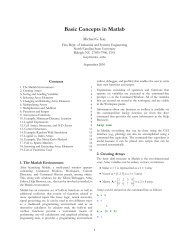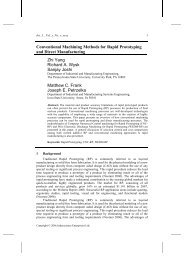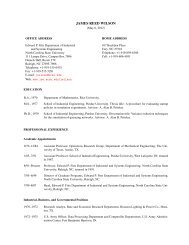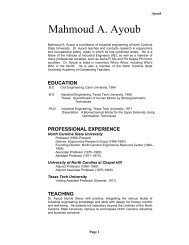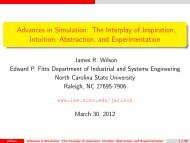Multiple Resources and Mental Workload - ResearchGate
Multiple Resources and Mental Workload - ResearchGate
Multiple Resources and Mental Workload - ResearchGate
You also want an ePaper? Increase the reach of your titles
YUMPU automatically turns print PDFs into web optimized ePapers that Google loves.
MULTIPLE RESOURCES AND MENTAL WORKLOAD 453<br />
is referred to as a “red line” of workload (Grier,<br />
2008).<br />
Task dem<strong>and</strong>, varying along this continuum,<br />
can result from either single-task dem<strong>and</strong> (e.g.,<br />
driving progressively faster on a winding road imposes<br />
progressively more resource dem<strong>and</strong>, until<br />
lane keeping begins to fail) or dual-task dem<strong>and</strong>.<br />
In characterizing single-task dem<strong>and</strong>, the “multiple”<br />
aspect of multiple resource theory has little<br />
relevance. Furthermore, whether one is doing one<br />
or two tasks in the “residual capacity” region, multiple<br />
resource theory is not fully germane. Only in<br />
the region where overload is imposed by multiple<br />
tasks does multiple resource theory make an<br />
important contribution to mental workload by predicting<br />
how much performance will fail once overload<br />
has been reached (i.e., the size of dual-task<br />
decrements). Here multiple resource theory can of<br />
course also provide guidance as to how redesign<br />
can restore performance to the residual capacity<br />
region.<br />
This distinction between regions is critical because<br />
most measures of workload are designed as<br />
much for the residual capacity region as for the<br />
overload region, if not more so (Gawron, 2008;<br />
Tsang & Vidulich, 2006). Secondary tasks are explicitly<br />
designed to probe “residual capacity” not<br />
used for a primary task; physiological <strong>and</strong> subjective<br />
measures operate across the entire range<br />
of both regions (<strong>and</strong> do not generally distinguish<br />
which resources, within the multiple resource<br />
framework, are used). Thus, the greatest value of<br />
such measures is to ensure that task dem<strong>and</strong>s can<br />
remain within the residual capacity region. Importantly,<br />
some models, such as IMPRINT © (Laughery<br />
et al., 2006) or MIDAS (Gore & Jarvis, 2005) do<br />
have a mental workload component, with task<br />
competition based on multiple resource theory <strong>and</strong><br />
with workload channels defined to correspond to<br />
the dimensions in Figure 1. However, this component<br />
is really intended to predict performance<br />
decrements in the overload region as a result of<br />
multitask requirements, which, as we saw, represents<br />
only one portion of the workload concept.<br />
Such models have been employed in important design<br />
decisions regarding workload <strong>and</strong> crew size<br />
(Booher & Minninger, 2003).<br />
FUTURE CHALLENGES FOR<br />
MULTIPLE RESOURCES<br />
Although the multiple resource model has been<br />
able to account for a good deal of variance in<br />
time-sharing efficiency when heterogeneous<br />
tasks are imposed (Horrey & Wickens, 2003; Liu<br />
& Wickens, 1992; Sarno & Wickens, 1995; Wickens<br />
& Colcombe, 2007; Wickens, Goh, Helleberg,<br />
Horrey, & Talleur, 2003; Wickens, S<strong>and</strong>ry, &<br />
Vidulich, 1983), both the theory <strong>and</strong> the model<br />
remain challenged by a number of issues. These<br />
include the following:<br />
• Adding another level to the modalities dimension,<br />
related to tactile input (Boles et al., 2007)<br />
• The fact that other mechanisms, unrelated to resources,<br />
also account for variance in dual-task performance.<br />
In particular, these relate to confusion<br />
between task elements (e.g., the problems of timesharing<br />
a perception <strong>and</strong> working memory task both<br />
using digits; Hirst & Kalmar, 1987) <strong>and</strong> cooperation<br />
between elements (e.g., dual-task processing supported<br />
by different dimensions of a single object;<br />
Duncan, 1979; Wickens & Holl<strong>and</strong>s, 2000).<br />
• The inability to characterize resource dem<strong>and</strong> on a<br />
single scale, on which the “red line” distinguishing<br />
the reserve capacity from the overload region can be<br />
placed (Hart & Wickens, 1990; Grier, 2008)<br />
• Underst<strong>and</strong>ing what drives the allocation policy. In<br />
the laboratory, this often can be driven by primary<br />
<strong>and</strong> secondary task instructions (Tsang, 2006), but in<br />
the real world, phenomena such as unwanted diversion<br />
of attention to interruptions (Trafton & Monk,<br />
2008), “cognitive tunneling” (Wickens & Alex<strong>and</strong>er,<br />
in press), <strong>and</strong> auditory preemption (Horrey<br />
& Wickens, 2004; Wickens & Colcombe, 2007;<br />
Wickens, Dixon, & Seppelt, 2005) often operate in<br />
ways that are clearly at odds with optimal allocation,<br />
as witnessed by the safety compromise of driving<br />
while using a cell phone (Strayer & Drews, 2007).<br />
Such findings are consistent with recent developments<br />
that allocation policy is a function closely related<br />
to that of the central executive, a construct well<br />
established to account for differences in time-sharing<br />
efficiency (Engle, 2002; Monsell, 2003; Wickens &<br />
McCarley, 2008), as well as to identifiable prefrontal<br />
brain regions (Kramer & Parasuraman, 2007).<br />
Such challenges await the allocation of research<br />
resources to the interested human factors investigator.<br />
ACKNOWLEDGMENTS<br />
I thank Dr. Bill Horrey <strong>and</strong> Dr. David Boles for<br />
their comments on this manuscript.<br />
REFERENCES<br />
Baddeley, A.D. (1986). Working memory. Oxford, UK: Clarendon.<br />
Bahrick, H. P., Noble, M., & Fitts, P. M. (1954). Extra task performance<br />
as a measure of learning a primary task. Journal of Experimental<br />
Psychology, 48, 298–302.


